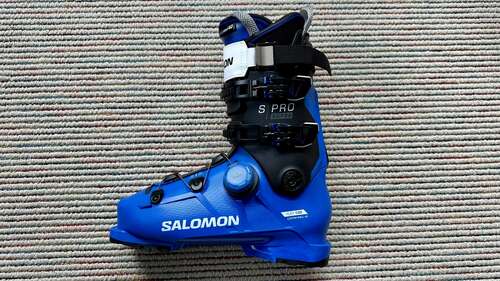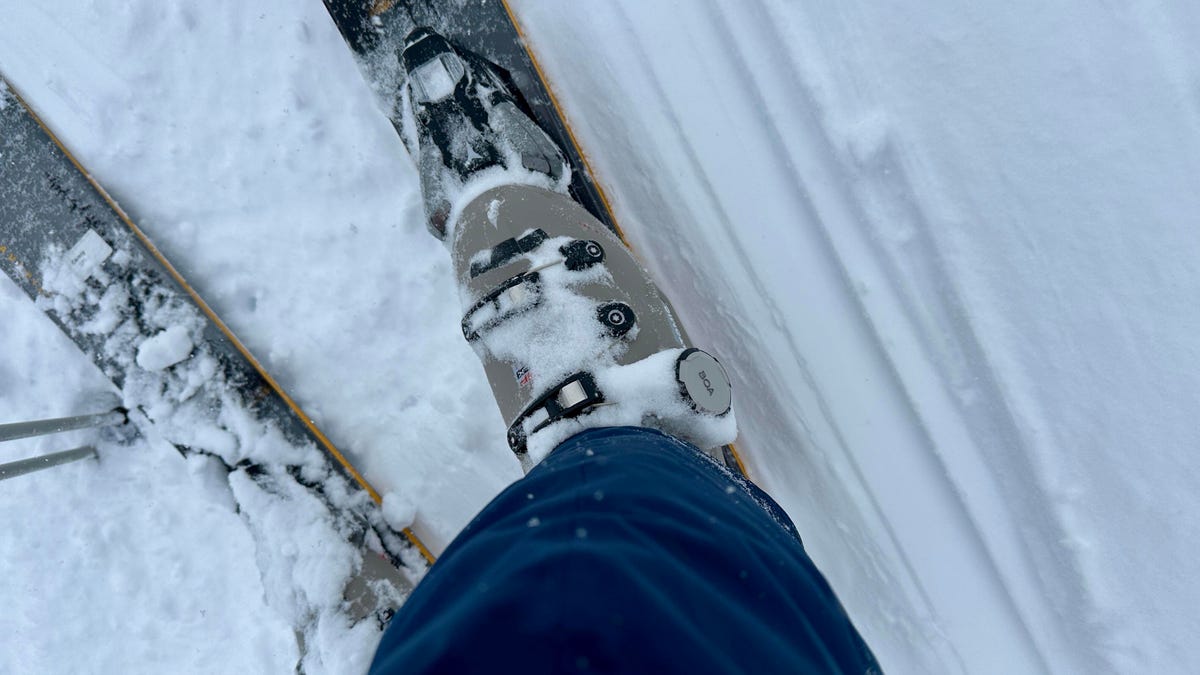Ski boots haven’t changed all that much in the last 15 to 20 years. The quality of the materials and the anatomical fit have improved a bit, along with post-purchase customizations options — upgraded moldable liners, for example — and new GripWalk soles. And while the backcountry/touring boot category has seen some significant advances, mainstream alpine ski boots just haven’t evolved in a big way, with most models still having four buckles for adjusting the boot’s fit.
That’s changing this year as new lines of boots from Atomic, Salomon, Fischer and K2 now feature BOA’s new H+i1 Fit System, which replaces the bottom two buckles with a dial. A few folks got a chance to try prerelease versions of the new boots last ski season, but they’re now on sale and available to the general public.
BOA dial/cable Fit Systems have been integrated into snowboarding boots since 2001. As a skier, I always envied boarders who just had to turn a couple of dials to tighten and loosen their boots, which are typically more comfortable than ski boots and much easier to walk in (the ones with softer exteriors anyway). While you’d think BOA would have figured out a way to get the snowboard tech into ski boots sooner, the dial/cable system proved tricky to implement satisfactorily for skiers from both design and performance standpoints. (Despite their similarities, skiing and snowboarding are very different disciplines.)
I tried on a couple of pairs of BOA-equipped ski boots: the Atomic Hawx Ultra 130 XTD BOA and Salomon S/Pro Supra BOA 130. These are men’s boots, but they’re also available in women’s versions, as well as a few different flex options — the 130 in the name refers to the stiffness of the boot, with that being the stiffest and usually the most expensive model in a line (prices for BOA-equipped boots start at around $600). More advanced skiers tend to want stiffer boots, but it’s also based on your personal taste and skiing style and such factors as weight and height. Rental boots tend to tap out at around a 90 flex, which isn’t quite stiff enough for most expert skiers.
More uniform wrap
The first thing I noticed when I put the boots on is that they’re slightly harder to get into than your typical ski boot that has two bottom buckles. You pull up on the dial to fully release the cable and push it in and turn it counter-clockwise to cinch it up. You can also loosen the cable without lifting the dial (you simply turn it clockwise). Your foot is a little harder to get in the boot because it doesn’t open that extra bit at the bottom when you release both buckles.
Once you get your foot in, the boot does feel a little different than a traditional ski boot that has two bottom buckles (I regularly use an older pair of the Atomic Hawx Ultra 130 boots so it was easy to compare). How the BOA boots wrap your foot feels a little different. It’s a more uniform wrap (buckles exert a certain amount of pressure on the top of the foot) that offers the same snugness all around your foot. And you can dial in that snugness more precisely. BOA says its system reduces peak pressure on the top of the foot by 13%.

The boots come in a few different flexes and are available for both women and men.
To be clear, these are not huge differences compared to non-BOA boots. But when it comes to ski boots, subtle differences in fit (for the better) can make a big difference. And just importantly, there’s the convenience of using the dial system. A lot of skiers — or at least those experiencing some discomfort from their boots — like to unbuckle the first bottom buckle or even both bottom buckles before getting on a chair lift, then tightening things back up before skiing down. Especially when it’s very cold and snowing hard, it can be a nuisance to have to get buckled back up, and it’s clearly much easier to reach down and turn a dial to tighten your boot (or loosen it). The dial is larger than many of the BOA dials out there (you can also find them on biking, hiking and even golf shoes), and I had no problem turning it with a glove on.
Testing them on-piste
When I initially wrote this article, I’d tried the boots on but hadn’t skied with them. In January, I finally got a chance to make some turns wearing them over four days at Jackson Hole and was generally impressed with the experience. BOA says you should get slightly better responsiveness and power transfer during turns, but I think most people will be more aware and appreciative of the differences in the fit and the ability to more precisely dial in the snugness of the boot around your foot.
At one point I did have an issue with losing some feeling in the big toe on my right foot. It could have been some frostnip — yes, it was very cold — but I also may have dialed in a little too much snugness (pain-free, I might add) and perhaps cut off some circulation. I dialed the tightness back a bit after a warm-up break in the lodge and that did help.
As you’d expect from high-end boots like the Atomic Hawx Ultra 130 XTD BOA (it also comes in 105 and 120 flex versions), the boot shop you buy them at will custom-fit the boot to your foot. Or, if you buy them online, you can take them to a boot shop and pay to get a custom fit (the mimic liner and memory fit shell can be molded for your foot). While the Salomon models cost a little less, their liners are also moldable, and a lot of folks buy upgraded footbeds or even custom footbeds that cost as much as the boot itself. And some boot experts at Jackson Hole recommended that, if I was really serious about getting the perfect fit, I should ditch the stock boot liner for a $500 ZipFit boot liner. Indeed, getting a comfortable ski boot fit can be an expensive proposition.
On a side note, I was a little surprised with how the ski community (at least in Jackson Hole) had embraced the new technology. In the boot shop, one of the technicians said he was initially skeptical about the new BOA ski boots but had been won over by them. And others, including a couple of ski patrollers, said they were fans of the new tech. Most of the shops had sold out of BOA boots.

The dial makes it easy to tighten and loosen your boots, even with gloves on, and delivers a more precise fit.
Back to the future
In the 1980s, boot makers like Salomon created rear-entry models like the SX60 that reduced the number of latches down to a single buckle. That was a somewhat short-lived fad, though Nordica and Atomic unveiled new rear-entry models back in 2019 and you can still find a few different rear-entry models on the market today, led by the Nordica HF series. That modernized rear-entry design does allow you to get in and out of a boot more easily, but you just won’t get the performance you get from one of these BOA-equipped boots.
A few years ago, I started to see more boot makers building heating elements into their boots (I tried a pair of K2s with a heating option), but that tech upgrade just hasn’t taken off and I’ve been told that heated ski socks, not heated boots, are the way to go, with Lens making some of the best heated socks (they’re around $175).
BOA-equipped ski boots do cost a little more than non-BOA boots. I wondered about the warranty on the system and what you would do if you happen to break off or damage one of those dials. BOA told me the Fit System is guaranteed for the life of the product and that they ensured that ski shops around the country have repair kits and replacement parts if needed, “and at no expense to the customer.” Customers can also access new parts through the BOA Warranty Team using BOAfit.com.
The big question, of course, is whether we’ll see completely buckle-free BOA-equipped systems with dials on both the bottom and top of the boots.
“BOA started in Alpine Ski by integrating the BOA Fit System in place of the lower two buckles because the team identified a clear issue for consumers (pressure points and poor fit negatively impacting performance) they could solve with BOA,” a BOA spokesperson told me. “Looking to further improve fit and performance, innovation is underway to extend within product lines, up the boot, and into new categories of alpine ski boots. There is more exciting evolution coming down the road. However, we cannot comment on ongoing projects with brand partners until they are in the market.”
Editors’ note: This story was originally published on Dec. 12., 2023 but has since been updated to include remarks about testing the boots at Jackson Hole in January, 2024.

